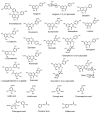Stinging Nettle (Urtica dioica L.): Nutritional Composition, Bioactive Compounds, and Food Functional Properties
- PMID: 36014458
- PMCID: PMC9413031
- DOI: 10.3390/molecules27165219
Stinging Nettle (Urtica dioica L.): Nutritional Composition, Bioactive Compounds, and Food Functional Properties
Abstract
Stinging nettle (Urtica dioica L., Urticaceae) is commonly found in Asia, Africa, and Europe and has a long history of being used as food and traditional medicine. Recently, this plant is gaining attention as a highly nutritious food, where fresh leaves are dried and used as powder or in other forms. Leaves are rich in many bioactive compounds. This review aims to cover the traditional uses in food and medicine, as well as its nutritional composition, including its bioactive chemical constituents and reported food functional activities. Various bioactive chemical constituents have been isolated from stinging nettle to date, such as flavonoids, phenolic acids, amino acid, carotenoids, and fatty acids. Stinging nettle extracts and its compounds, such as rutin, kaempferol, and vitamin A, are also used for their nutritional properties and as anti-inflammatory and antioxidant agents. Future studies should focus on the proper formulation and stability testing of the functional foods containing stinging nettle and their detailed activities in clinical studies.
Keywords: Urtica dioica; anti-bacterial; anti-inflammatory; anti-ulcer; antioxidant; nettle; nutraceuticals; stinging nettle.
Conflict of interest statement
The authors declare no conflict of interest.
Figures



References
-
- Atanasov A.G., Waltenberger B., Pferschy-Wenzig E.M., Linder T., Wawrosch C., Uhrin P., Temml V., Wang L., Schwaiger S., Heiss E.H., et al. Discovery and Resupply of Pharmacologically Active Plant-Derived Natural Products: A Review. Biotechnol. Adv. 2015;33:1582–1614. doi: 10.1016/j.biotechadv.2015.08.001. - DOI - PMC - PubMed
-
- Wadhwa R., Paudel K.R., Chin L.H., Hon C.M., Madheswaran T., Gupta G., Panneerselvam J., Lakshmi T., Singh S.K., Gulati M., et al. Anti-Inflammatory and Anticancer Activities of Naringenin-Loaded Liquid Crystalline Nanoparticles In Vitro. J. Food Biochem. 2021;45:e13572. doi: 10.1111/jfbc.13572. - DOI - PubMed
Publication types
MeSH terms
Substances
LinkOut - more resources
Full Text Sources

